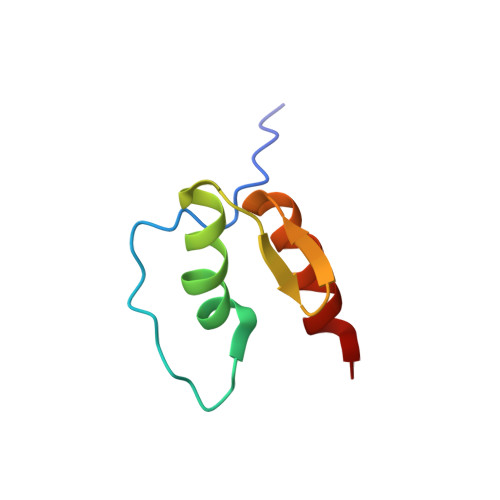Dissecting the stability determinants of a challenging de novo protein fold using massively parallel design and experimentation.
Kim, T.E., Tsuboyama, K., Houliston, S., Martell, C.M., Phoumyvong, C.M., Lemak, A., Haddox, H.K., Arrowsmith, C.H., Rocklin, G.J.(2022) Proc Natl Acad Sci U S A 119: e2122676119-e2122676119
- PubMed: 36191185
- DOI: https://doi.org/10.1073/pnas.2122676119
- Primary Citation of Related Structures:
7T2F, 8DOA - PubMed Abstract:
Designing entirely new protein structures remains challenging because we do not fully understand the biophysical determinants of folding stability. Yet, some protein folds are easier to design than others. Previous work identified the 43-residue ɑββɑ fold as especially challenging: The best designs had only a 2% success rate, compared to 39 to 87% success for other simple folds [G. J. Rocklin et al., Science 357, 168-175 (2017)]. This suggested the ɑββɑ fold would be a useful model system for gaining a deeper understanding of folding stability determinants and for testing new protein design methods. Here, we designed over 10,000 new ɑββɑ proteins and found over 3,000 of them to fold into stable structures using a high-throughput protease-based assay. NMR, hydrogen-deuterium exchange, circular dichroism, deep mutational scanning, and scrambled sequence control experiments indicated that our stable designs fold into their designed ɑββɑ structures with exceptional stability for their small size. Our large dataset enabled us to quantify the influence of universal stability determinants including nonpolar burial, helix capping, and buried unsatisfied polar atoms, as well as stability determinants unique to the ɑββɑ topology. Our work demonstrates how large-scale design and test cycles can solve challenging design problems while illuminating the biophysical determinants of folding.
Organizational Affiliation:
Driskill Graduate Program in Life Sciences, Northwestern University Feinberg School of Medicine, Chicago, IL 60611.














